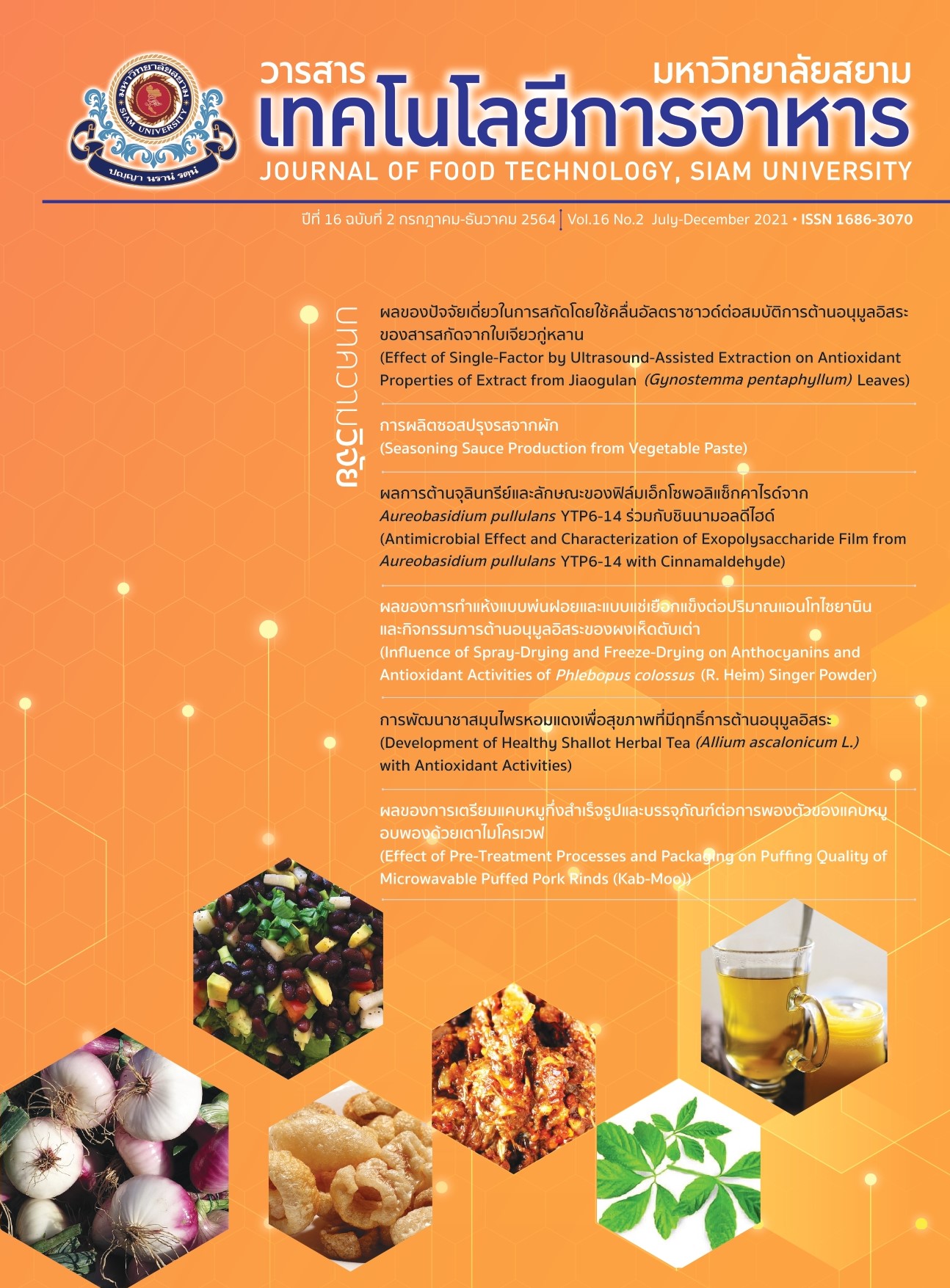ผลของการเตรียมแคบหมูกึ่งสำเร็จรูปและบรรจุภัณฑ์ต่อการพองตัวของแคบหมูอบพองด้วยเตาไมโครเวฟ
Main Article Content
บทคัดย่อ
งานวิจัยครั้งนี้มีวัตถุประสงค์เพื่อศึกษาวิธีการเตรียมแคบหมูกึ่งสำเร็จรูป และบรรจุภัณฑ์สำหรับอบแคบหมูให้พองตัวด้วยเตาไมโครเวฟ โดยศึกษาเวลาการต้มหนังหมูในน้ำมัน (นาน 2-6 ชั่วโมง) ความยาวของแคบหมูกึ่งสำเร็จรูป (1-3 เซนติเมตร) กำลังไฟของเตาไมโครเวฟ (700 และ 900 วัตต์) ชนิดของบรรจุภัณฑ์สำหรับอบแคบหมูด้วยเตาไมโครเวฟ (ถุงกระดาษ ถุงพลาสติก และกล่องพลาสติก) และน้ำหนักบรรจุ (14-22 กรัม) ผลพบว่า ระยะเวลาการต้มหนังหมูในน้ำมันที่นานขึ้น มีผลให้ความชื้นในแคบหมูกึ่งสำเร็จรูปลดลง ซึ่งมีผลให้อัตราการพองตัวมีแนวโน้มเพิ่มขึ้น ในขณะที่ค่าความแข็งมีแนวโน้มลดลง การบรรจุแคบหมูกึ่งสำเร็จรูปในบรรจุภัณฑ์และน้ำหนักบรรจุที่แตกต่างกัน มีผลต่ออัตราการพองตัว และค่าความแข็งของแคบหมูแตกต่างกันอย่างมีนัยสำคัญ (p≤0.05) โดยวิธีการเตรียมแคบหมูกึ่งสำเร็จรูปที่เหมาะสม คือ แคบหมูกึ่งสำเร็จรูปมีความยาวเส้น 3 เซนติเมตร ที่ผ่านการต้มในน้ำมันนาน 5 ชั่วโมง 30 นาที และบรรจุแคบหมูกึ่งสำเร็จรูปในถุงกระดาษ ถุงพลาสติก และกล่องพลาสติกสำหรับอบในเตาไมโครเวฟ ด้วยน้ำหนักบรรจุในช่วง 16-18 กรัมต่อบรรจุภัณฑ์ สามารถอบให้พองตัวพร้อมภาชนะบรรจุด้วยเตาไมโครเวฟที่กำลังไฟ 700 วัตต์ ได้แคบหมูที่มีค่าอัตราการพองตัว และความแข็งไม่แตกต่างกันอย่างมีนัยสำคัญ (p>0.05)
Article Details

อนุญาตภายใต้เงื่อนไข Creative Commons Attribution-NonCommercial-NoDerivatives 4.0 International License.
บทความทุกบทความในวารสารเทคโนโลยีการอาหาร ทั้งในรูปแบบสิ่งพิมพ์ และในระบบออนไลน์ ถือเป็นลิขสิทธิ์ของมหาวิทยาลัยสยาม และได้รับการคุ้มครองตามกฎหมาย
เอกสารอ้างอิง
Thai Industrial Standards Institute (TISI). (2010). The community product standards: Deep-fried pig skin TISI 101/2553. Accessed May 20, 2021 from จ. (in Thai).
Bunthawong, O., Krutarote, K. and Juyjaroen. N. (2006). Microwavable crispy pork rind (Kab moo). Thailand Research Fund (TRF) report, Bangkok. (in Thai).
Rattanapanon, N. (2015). Basic principles of food processing (2nd ed.). Odeon Store, Bangkok. (in Thai).
Rajavithi hospital. (2017). The dangers of re-frying oil. [Online] Available from https://www.rajavithi.go.th/ [Accessed May 20, 2021]. (in Thai).
Wongthong, O. and Poonpolkul, K. (2017). Cooking principles (14th ed.). Kasetsart University Press, Bangkok. (in Thai).
Bunthawong, O., Jinakran, L. and Juyjaroen, N. (2005). Processing of crispy pork rind (Kab moo) by baking method. Thailand Research Fund (TRF) report, Bangkok. (in Thai).
Sriwattana, S., Utama-ang, N., Thakeow, P., Senapa, J., Phimolsiripol, Y., Surawang, S., Pongsirikul, I. and Angeli, S. (2012). Physical, chemical and sensory characterization of the Thai-crispy pork rind ‘Kaeb moo’. Chiang Mai University Journal of Natural Sciences Special Issue on Agricultural & Natural Resources. 11(1): 181-191.
Jantawat, P., Niyomvit, N. and Keawcumnerd, T. (1989). The effects of moisture content, moisture equilibration and frying temperature on the quality of pork rind snack (Kaeb-moo). Food Journal. 19(2): 79-88. (in Thai).
Bunthawong, O. (2012). Development of style and package for microwavable crispy pork rinds (Kab moo). Thailand Research Fund (TRF) report, Bangkok. (in Thai).
Jomduang, S. (1994). Modification and improvement of Khao Kriap Waue (A traditional Thai glutinous rice-based snack food). Doctoral desertatia, University Pertanian, Malaysia.
Association of Official Analytical Chemists. (2005). Official method of analysis (18th ed.). USA.
Charnthankorn, T. (1999). Development of Keab-moo product and consumer test. Unpublished master’s thesis, Chiang Mai University, Thailand. (in Thai).
Decareau, R.V. (1992). Microwave foods. In New product development food and nutrition. The AVI Publishing Company, Connecticut.
Ni, H., Datta, A. and Torrance, K. (1999). Moisture transport in intensive microwave heating of biomaterials: A multiphase porous media model. International Journal of Heat and Mass Transfer. 42(8): 1501-1512.
Sahin, S. and Sumnu, S.G. (2006). Physical properties of foods. Springer Science and Business Media, New York.
Singh, R.P. and Heldman, D.R. (2008). Heat transfer in food processing, pp 247-401. In Singh, R.P. and Heldman, D.R. (ed.). Introduction to food engineering (4th ed). Elsevier, Burlington.
Thao, T.N., Le, T.Q. and Songsermpong, S. (2013). Shrimp cassava cracker puffed by microwave technique: effect of moisture and oil content on some physical characteristics. Kasetsart Journal (Natural Sciences). 47(3): 1-13.
Yan, W.Q., Zhang, M., Huang, L.L., Tang, J., Mujumdar, A.S. and Sun, J.-C. (2010). Study of the optimization of puffing characteristics of potato cubes by spouted bed drying enhanced with microwave. Journal of the Sciences of Food and Agriculture. 90(8): 1300-1307.
Tiwthan, O. (2014). Study of salmon skin puffing by microwave oven and frying. Unpublished master’s thesis, Prince of Songkla University, Thailand. (in Thai).
Matz, S.A. (1970). Manufacture of breakfast cereals, pp. 547-566. In S.A. Matz (ed.). Cereal Technology. The AVI Publishing Company, Connecticut.
Sumnu, G. and Sahin, S. (2005). Recent developments in microwave heating, pp 419-444. In D. Sun (ed.). Emerging Technologies for food processing. Elsevier Academic Press, Italy.
Nirav, D.J., Debabandya, M., Dinesh, C.J. and Sutar, R.F. (2014). Puffing characteristics of parboiled milled rice in a domestic convective microwave oven and process optimization. Food and Bioprocess Technology. 7(6): 1678-1688.
Varnalis, A.I., Brennan, J.G. and MacDougall, D.B. (2004). Optimisaton of high temperature puffing of potato cubes using response surface methodology. Journal of Food Engineering. 61(2): 153-163.
Maskan, M. (2001). Drying, shrinkage and rehydration characteristics of kiwifruits during hot air and microwave drying. Journal of Food Engineering. 48(2): 177-182.
Alibas, I. (2006). Microwave, air and combined microwave-air drying parameters of pumpkin slices. LWT-Food Science and Technology. 40(8): 1445-1451.
Praditdoung, S. and Ratanasumawong, S. (2017). Food Science and Technology I: radiation in food processing and preservation (2nd ed). Kasetsart University Press, Bangkok. (in Thai).


